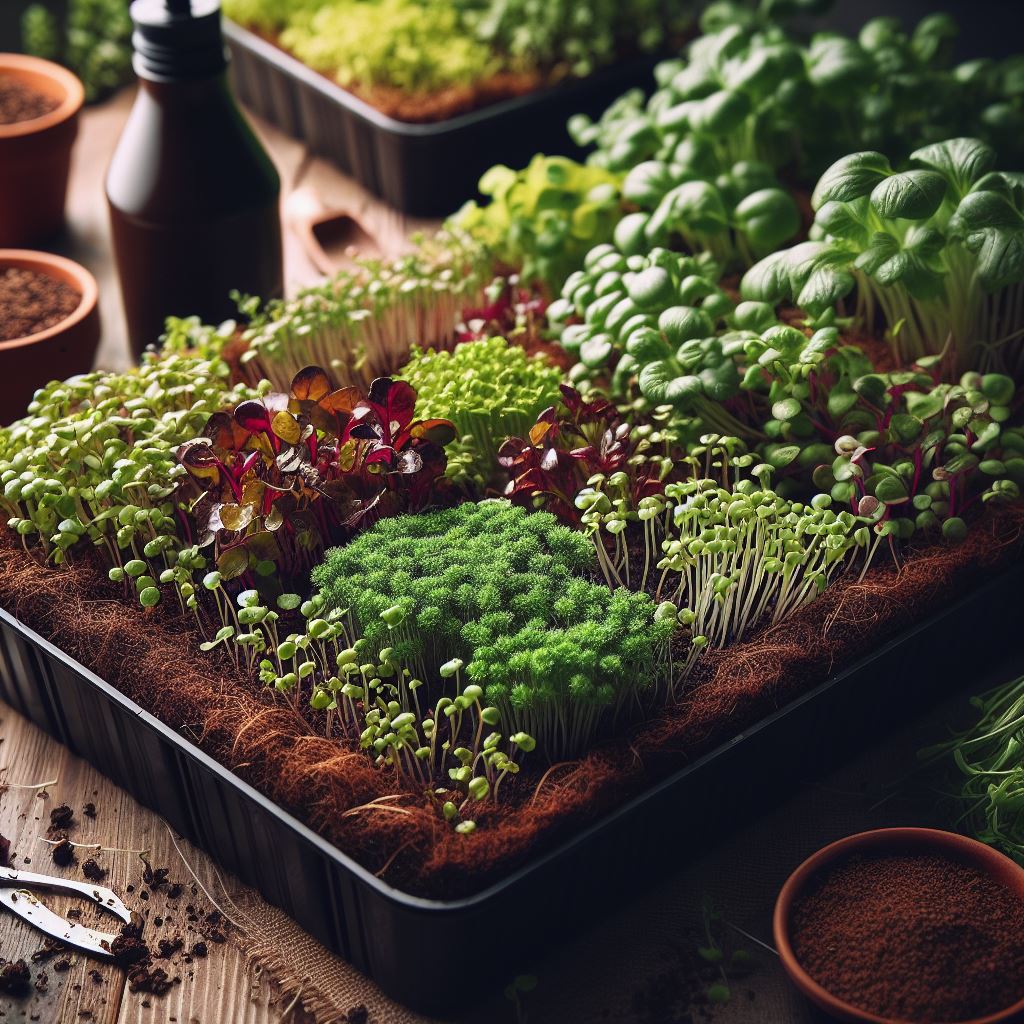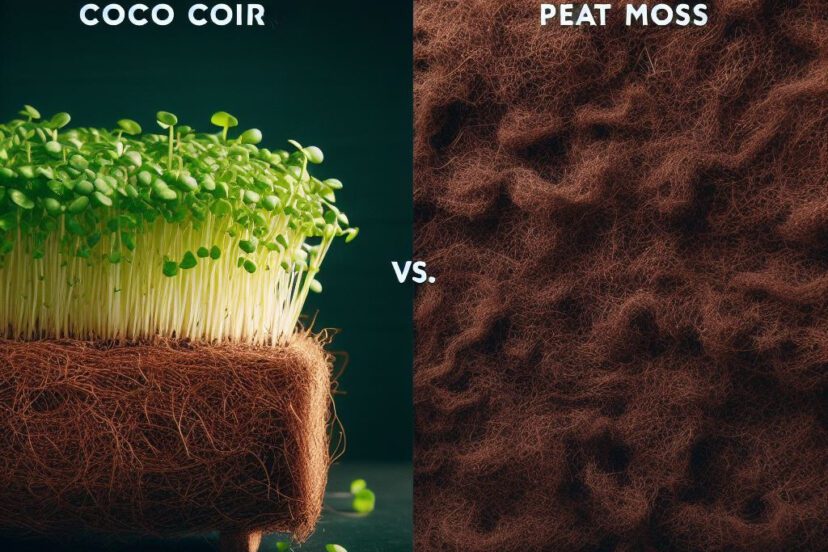Coco Coir vs. Peat Moss: Which is Better for Microgreens?
As a dedicated microgreens enthusiast, I’ve spent countless hours experimenting with different growing mediums to find the perfect match for these tiny greens. The choice between Coco Coir and Peat Moss is a pivotal one, and in this article, we’ll explore the merits of each to help you make an informed decision.
Introduction
In my journey as a devoted microgreens enthusiast, I’ve spent years experimenting with different growing mediums to find the perfect match for these miniature powerhouses. The debate between Coco Coir vs Peat Moss is crucial, and in this article, we’ll delve into the merits of each to help you make an informed decision. Whether you’re a seasoned grower or just starting out, understanding the nuances of these mediums can make a world of difference in the success of your microgreens venture.
Understanding Microgreens
Before we dive into the comparison, let’s take a moment to understand what microgreens truly are. These miniature greens are essentially the seedlings of edible vegetables and herbs. They are harvested at an early stage, usually when the first true leaves emerge. This early harvest ensures that you’re getting a burst of flavor and nutrients in every bite.
The Role of Growing Mediums
The growing medium acts as a nurturing bed for your microgreens, providing them with the essential support they need to grow strong and healthy. When it comes to Coco Coir and Peat Moss, both have their unique qualities that can greatly influence the growth of your microgreens.
Coco Coir: A Closer Look
Derived from the husks of coconuts, Coco Coir is a natural and eco-friendly option that has gained popularity among growers. Its fibrous structure allows it to retain moisture exceptionally well, ensuring a consistent supply of water to your plants. Additionally, it provides excellent aeration, preventing root diseases and promoting healthy root development.

Peat Moss: An Alternative Choice
Peat Moss, a tried-and-true favorite among gardeners, is derived from decomposed sphagnum moss. It’s known for its ability to retain moisture, making it an excellent choice for microgreens. However, it’s worth noting that there are environmental concerns surrounding the extraction of peat moss, which may influence your decision.
Coco Coir vs. Peat Moss: A Comparison
Let’s conduct a detailed comparison of Coco Coir vs Peat Moss, considering key factors that can impact your microgreens’ growth:
- Moisture Retention: Coco Coir’s ability to retain moisture is unparalleled, ensuring a consistent water supply for your microgreens. Peat Moss also retains water well, but may require more frequent watering in comparison.
- Aeration: Coco Coir provides excellent aeration, creating an optimal environment for root health. On the other hand, Peat Moss can become compacted over time, potentially affecting aeration.
- pH Levels: Coco Coir tends to have a near-neutral pH, which is suitable for a wide range of crops. Peat Moss, however, is naturally acidic, which might necessitate pH adjustments for certain plants.
- Nutrient Content: While both mediums can be relatively low in nutrients, Coco Coir typically requires more frequent fertilization. Peat Moss may have some initial nutrient content, but additional supplementation might still be necessary.
Benefits of Coco Coir for Microgreens
Choosing Coco Coir for your microgreens cultivation comes with a host of benefits:
- Exceptional moisture retention ensures a steady water supply.
- Outstanding aeration promotes robust root systems and prevents root diseases.
- Neutral pH levels make it versatile for various crops.
- Eco-friendly and sustainable, utilizing a waste product (coconut husks).
Advantages of Peat Moss for Microgreens
Peat Moss, with its longstanding reputation in gardening, also offers its own set of advantages:
- Effective moisture retention, providing a reliable water source for your plants.
- Widely available and often more budget-friendly than Coco Coir.
- Contains some initial nutrients, which can support early growth.
- Proven track record of success in horticulture.

Environmental Considerations
Considering the environmental impact of your growing medium is crucial. Coco Coir is often favored for its sustainable sourcing, utilizing a byproduct of the coconut industry. Peat Moss, however, raises concerns about the depletion of peat bogs, which are slow to regenerate.
Cost Analysis
While Peat Moss is generally more budget-friendly upfront, it’s essential to weigh the long-term benefits and sustainability of your chosen medium. Coco Coir may have a higher initial cost, but its longevity and eco-friendly nature could make it a more cost-effective choice in the long run.
Tips for Using Coco Coir
If you decide to go with Coco Coir, consider these tips for optimal results:
- Pre-soak the coir to allow it to expand fully before use.
- Use it as a base for your microgreens, providing them with a stable and nutrient-rich environment.
- Monitor moisture levels carefully to prevent overwatering, ensuring your plants thrive.
Tips for Using Peat Moss
For those leaning towards Peat Moss, here are some pointers to keep in mind:
- Pre-moisten the peat moss to make it more manageable and ensure even moisture distribution.
- Consider blending it with other growing mediums to enhance aeration, creating an optimal environment for root development.
- Pay close attention to pH levels, as Peat Moss tends to be naturally acidic. Adjustments may be necessary depending on the plants you’re growing.
Real-Life Experiences
It’s invaluable to tap into the experiences of fellow microgreens growers. Online forums and communities are treasure troves of insights, where enthusiasts share their successes, challenges, and best practices with both Coco Coir and Peat Moss.
Making Your Choice
Ultimately, the decision between Coco Coir and Peat Moss hinges on your specific needs, budget constraints, and environmental considerations. Both mediums have their unique strengths, so it’s worth taking the time to evaluate your priorities and the specific types of microgreens you intend to grow.
Expanding the Benefits of Coco Coir
While Coco Coir has already been lauded for its moisture retention and aeration properties, it’s worth emphasizing the additional advantages it brings to the table.
Enhanced Disease Resistance
Coco Coir has natural antifungal properties, providing an added layer of protection against common soil-borne diseases. This can be a game-changer for microgreens growers, as maintaining a disease-free environment is paramount for successful cultivation.
Sustainable Sourcing: A Win-Win
The sustainability factor of Coco Coir cannot be overstated. By utilizing a byproduct of the coconut industry that would otherwise go to waste, you’re not only contributing to a more sustainable horticultural practice but also supporting an industry that promotes responsible resource utilization.
Peat Moss: Navigating Environmental Concerns
While Peat Moss has proven its worth as a growing medium over the years, it’s important to address the environmental considerations associated with its extraction.
Exploring Alternatives
Given the slow regeneration of peat bogs, exploring alternatives to Peat Moss becomes imperative for environmentally-conscious growers. Coco Coir, with its renewable and eco-friendly sourcing, presents itself as a compelling option that aligns with sustainable horticulture practices.
Realizing the Long-Term Benefits
When assessing the cost analysis of Coco Coir versus Peat Moss, it’s essential to factor in the long-term benefits of each medium.
Investing in Sustainability
While the initial investment in Coco Coir may be slightly higher, its durability and sustainable sourcing contribute to a more cost-effective solution in the long run. Moreover, the reduced environmental impact of using a renewable resource is a long-term investment in the health of our planet.
Conclusion
In the spirited debate of “Coco Coir vs. Peat Moss for Microgreens,” there’s no one-size-fits-all answer. Coco Coir shines in its exceptional moisture retention and sustainable sourcing, while Peat Moss offers affordability and a track record of success. Your choice will ultimately be a reflection of your priorities and the particular requirements of your microgreens project.
FAQs
1. Is Coco Coir better than Peat Moss for all types of microgreens?
The suitability of the medium depends on the specific needs and preferences of the microgreens you’re growing. Coco Coir’s versatility makes it a strong contender, but Peat Moss may excel for certain varieties.
2. Are there any environmental concerns with using Peat Moss?
Yes, there are environmental concerns associated with using Peat Moss. The extraction of peat moss involves the depletion of peat bogs, which are fragile ecosystems that can take centuries to regenerate. This raises significant sustainability concerns.
3. How can I adjust the pH of Coco Coir or Peat Moss if needed?
Adjusting the pH of your growing medium is crucial for the health of your microgreens. To raise the pH, you can add lime. To lower it, you can add sulfur. It’s important to regularly monitor and adjust the pH levels to suit the specific needs of your chosen plants.
4. Can I mix Coco Coir and Peat Moss for my microgreens?
Absolutely! Combining Coco Coir and Peat Moss can result in a growing medium that harnesses the strengths of both. This blend can provide excellent moisture retention, aeration, and a stable base for your microgreens to thrive.
5. Which medium is more beginner-friendly for growing microgreens?
For beginners, Coco Coir is often considered a more forgiving option. Its exceptional moisture retention and near-neutral pH make it easier to work with, reducing the likelihood of overwatering or pH-related issues that can sometimes be encountered with Peat Moss.




